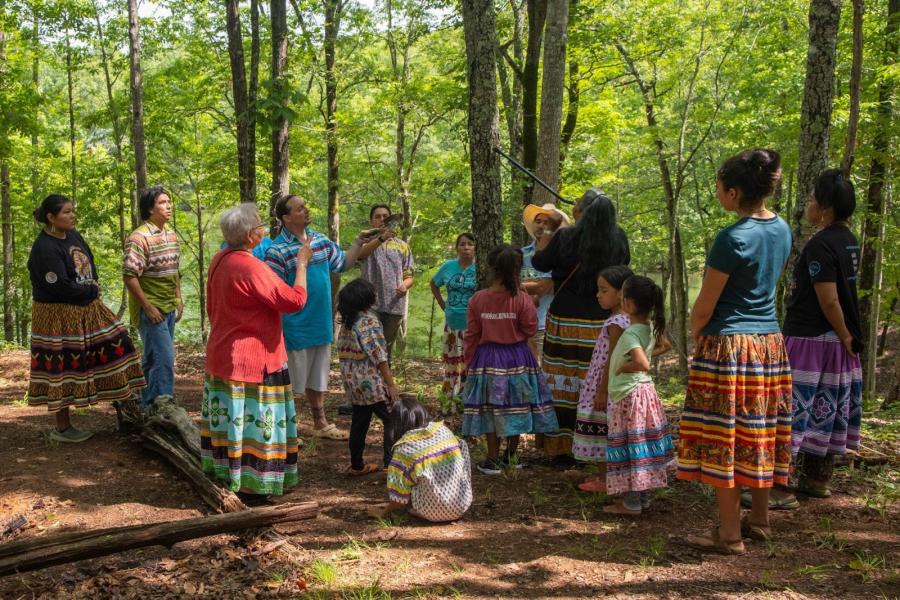Tucked away in the foothills near the floor of the Sacramento Valley in Northern California is a small community of ranchers who have preserved their ownership of the land and their way of life, almost intact from the nineteenth century. How this community successfully met and resolved the challenge of environmental regulation and of endangered species public trust mandates is a story that may show that conflict between cattlemen, government and environmentalists may not always have to end up in legal or legislative battles.
The Community of Vina was founded by settlers who came to California with the great gold rush westward migration. One of the emigrant trails into the great Central Valley skirted the flanks of Mt. Lassen, the southernmost volcano tapping into the great Cascadia subduction zone. Periodic eruptions of Mt. Lassen, the last occurring in 1914, have created a wide sloping plain of oak studded grasslands. There, creeks that drain the slopes of Mt. Lassen run through deep canyons carved into paleozoic sediments that underlie dark volcanic surface rocks. Deer Creek drains the southern flanks of the mountain, forming a long narrow watershed that trends southwesterly towards the valley floor where it joints the Sacramento River. Local traditions
Before the settlers came, the land was inhabited by the Yahi people who made their living by hunting the deer that grazed the foothills and by harvesting oak acorns from which a nutritious meal was made. They practiced active management of the landscape, burning it to prevent overgrowth to brush and chaparral. Seasonal burning promoted the native perennial bunch grasses and kept the ground clear around the oak trees so acorns could be gathered. With the coming of spring and the melting of the snowpack, the deer would move into the higher terrain to graze the meadows at the headwaters of Deer Creeks. The Yahi people would follow, moving their camps with the deer.
Another animal, the spring-run Chinook salmon, migrated up Deer Creek in the spring. After two or three years in the cold dark waters of the Pacific Ocean, these fish would find their way up the Sacramento River into Deer Creek. After ascending the lower canyon, the spring-run salmon would find a deep pool below a cascade where they would spend the whole summer dormant in the icy water. It does not rain much in the summer in these mountains. The salmon waited until the fall storms increased stream flows in Deer Creek. Then, they would move up to spawn just below the headwaters meadows, dying afterwards and leaving their carcasses for the bears. Their progeny would emerge from the stream bed gravel in the spring to spend a year living in Deer Creek before obeying their genetic urge to follow the flow of the creek and the river to sea. "And in a sense we were a tribe too," says Sue Knox, a descendant of the first settlers speaking of their way of life. "We lived off the land in the proper seasons, we learned that you never took more than you needed." The early settlers in the Deer Creek Basin herded sheep. In the spring they drove their flocks into the high country along the trails that the Yahi deer hunters had made, following an Immemorial pattern. "The Indians knew when to travel to follow the deer," says Knox. "You know not to overgraze - you learn a balance. The main thing is to know where you are, to know if you are on good or bad ground, so you know how to graze it. That's where the government goes `off the beam' - they make the same grazing rules for everywhere. The old-timers learned the hard way from overgrazing and studying the land."
The local tradition in the Deer Creek area is that the settlers adopted the practice of burning the foothills from the Yahi. There was, according to Sue Knox, a friendly early relationship between the settlers and the Yahi. Later, in hard times, the ranchers would leave food on their back porches for the Indians. By then, the tribal people were afraid of whites because a group of merchants at Red Bluff, the county seat, were paying bounty hunters to bring in the Indians dead or alive. Finally, in 1910m Ishi, the last Yahi, became famour by escaping to Oroville and becoming the subject of an anthropological investigation by A.L. Kroeber. "He followed the ridge down there from Deer Creek," says Sue Knox, whose grandfather was one of Kroeber's informants. Changes in land and resources use
Government regulation of the ranchers' way of the life began with the prohibition of burning around 1900. State fire control laws controlling burning on privately owned lands, and the creation of Lassen National Forest with a similar fire suppression regime, began to alter the landscape. As brush spread across the lower forest zone and markets changed, the ranchers shifted to cattle production.
Cattle ranching in the dry Mediterranean climate necessitated irrigated pastures for fodder. Some farmers located at the lower end of the creek turned to orchard which requires irrigation in California. The need for summer irrigation led to the formation of two small irrigation entities which constructed water diversion dams on Deer Creek around 1900, with ditch systems to the pastures and orchards. Because the people of Vina had a tradition of caring about the salmon which were still going up Deer Creek in great numbers every spring, they acceded to the requests of state fish and game biologists of that time to construct fish ladders on the dams, so the salmon could pass over the dams. Later, when it was realized that the young salmon on their way to sea could be drawn into the irrigation ditches, the ranchers cooperated in the construction of fish screens which would guide the little fish downstream. "Sometimes there were so many salmon you really could have walked across the creek on their backs" says Knox. "It wasn't just that we liked to fish for them, my father loved just to see them in the creek." Not withstanding the good feelings, in 1992 when a drought brought on a water rights dispute, the adjudication that resolved it left no legally enforceable flows in the creek for the fish.
Even so, generally, the two water districts would cooperate on a voluntary basis with the California Department of Fish and Game to informally provide the flows needed for upstream and downstream migration.
Last ownership in the Deer Creek Basin had evolved into a pattern of federal and industrial timberlands at the headwaters (Lassen National Park and Forest, Collins Pine). Lower in the foothills, large tracts were owned by cattle ranchers for pasturage. In the lower end of the watershed, the smaller irrigated areas were located. Because of the inaccessibility of much of the basin, the strong commitment to private land ownership, trespass prevention and family values, Vina as a community has changed very little since the nineteenth century compared to most of California. While having many of the kinship and mutual assistance in emergency ties found in rural areas, the community had still become somewhat fragmented as economic pressures on ranching increased. All that was about to change. Resource exploitation
From the point of view of an urban environmentalist, Deer Creek represented a classic case of rural resource exploitation. The land was grazed by cattle. To some environmentalists it appeared to be overgrazed. The loss of grasslands due to fire suppression policies was not well known or understood by outsiders.
Spring-run Chinook salmon had declined dramatically during the 1970s and 1980s. By 1992, two public interest environmental organizations, the Sierra Club Legal Defense Fund and the Natural Heritage Institute, began acting on input from concerned fisheries biologists. The organizations were considering whether to formally perdition the federal National Marine Fisheries Service (NMFS), which has responsibility for the protection of salmon, to list spring-run Chinook salmon under the Federal Endangered Species Act (ESA).
There was agreement among conservation biologists that the primary factor causing the decline of the spring-run salmon was probably not in Deer Creek, nor in the sport and commercial salmon fisheries in the ocean. Rather, the problem lay in the complex maze of sloughs and channels which conveyed the out-flowing waters of the Sacramento River through its inland delta. Increasing amounts of these flows had been diverted from the delta into a huge pumping plant and canal complex which conveyed the water to Southern California for municipal, industrial and agricultural use. As water exports increased, salmon populations declined. From the standpoint of the environmentalists, an ESA listing made sense. It would hurt the fishermen and the ranchers on Deer Creek first but, ultimately, it might slow down the pumping in the delta.
In addition, an environmental organization, Friends of the River, was directly concerned about Deer Creek. Lassen National Forest was conducting timber sales in the headwaters of Deer Creek that potentially could damage its still pristine waters with sediment. Some rancher-owned meadows in the headwaters suffered from cattle damage to the riparian areas near the stream. The trees which provide essential shade and food could not grow along the stream.
The construction of state highway 32 along a portion of Deer Creek in the 1930s had opened it to public access. The U.S. Forest Service had built several campgrounds along the creek. This exposed the summering adult spring-run Chinook to illegal poaching.
Friends of the River formally proposed that Deer Creek be designated for protection under the federal and state Wild and Scenic River Acts. This statutory protection would prevent logging for a quarter mile on each side of the creek; it would also prevent the construction of any new dams on the creek.
When some of the ranchers became aware of the proposed wild and scenic designation, they were concerned from the start. The experience of burning prohibition and grazing allotments on the National Forest had not been positives for them. Neighbors started getting together to read the provisions of the wild and scenic laws. While they had no basic problem with the "no additional dam" prohibition (the waters of the creek were already fully appropriated), they had a huge problem with a little known section of the law which would possibly open the banks of the river to public access across their privately owned lands. Says Sue Knox, "While we have respect for outsiders - most of them are as careful as we are - there are disrespectful people we don't want on our land; they leave gates open and trash under the bridges." Also, local fisherman were concerned about additional harassment of spring salmon. The ranchers started having regular meetings. Chris Leninger, the wife of a fourth generation rancher, emerged as a leader at these meetings. "We have always been a close community," says Sue Knox, "but this issue brought everyone together. At the meetings everyone got to have their say."
At the same time, commercial salmon fishermen who harvest salmon in the near shore Pacific ocean had been contacted through their trade organization, the Pacific Coast Federation of Fishermen's Associations (PCFFA), by the environmental organizations that were pushing the ESA listing for spring-run salmon. There was a history of cooperation between the environmental groups and PCFFA because they had a common interest, the protection of freshwater habitat for salmon. When queried as to whether PCFFA could support an ESA listing for spring-run, PCFFA responded that it would close the commercial fishery on the abundant fall-run Chinook salmon, which it could not support. Instead PCFFA proposed an alternative strategy: a voluntary simulation of the ESA recovery process, which PCFFA would take a lead role in organizing. After discussion, the environmental groups agreed to a grace period before pushing the listing.
PCFFA started by getting together with the biologists to learn what the problems were. At the first meeting, that became known as the Spring-Run Chinook Salmon Work Group, Deer Creek and nearby Mill Creek were identified as having remnant spring-run populations. Protection and restoration of habitat in these creeks was identified as top priority in that first meeting. By the third meeting of this small groups of rice farmers, local environmentalists, government fisheries biologists and fisherman, the work group had begun to focus on habitat protection in the headwaters of Deer and Mill Creeks. Prevention of poaching was identified as an early high priority issue. Collaboration and cooperation
By the eighth monthly meeting of the work group in July 1993, the people from Deer Creek had heard about it and decided to get involved. They came to the meeting which was held at a U.S. Forest Service district ranger station near the headwaters of Deer Creek and put their issues on the table. The Deer Creek community wanted everyone to understand that they were as concerned about salmon as were the fishermen and environmentalists. Second, they made it very clear that whatever solutions existed to problems for salmon in Deer Creek, they should be addressed on a local level by local people, not by government or outsiders telling them what to do. The work group, in the discussion that followed, achieved consensus that habitat restoration action should be planned in the watershed by an entity that the landowners would create themselves.
The Bacclala Family, who had owned Deer Creek Meadow since gold rush days, shared their sense of stewardship of the land with the group and invited everyone to see for themselves on the ground. The invitation was promptly accepted, and a field trip to visit the site was planned for the next day. Standing by the blanks of Deer Creek, Clinton "Tuck" Baccala asked members of the work group what they saw there that was not good for fish. The lack of riparian trees and vegetation was pointed out by several of the biologists present. Not much was said after that, and the group went on to look at timber harvest areas in the forest. However, a process of discussion among the ranchers had begun to focus on slamon.
After a long winter of many meetings at which a variety of watershed-planning organization models were examined and gleaned for ideas, the Deer Creek community settled on the concept of a conservancy. Voting membership in Deer Creek Conservancy was limited to landowners in the watershed. The overall strategy of response to the challenge of wild and scenic river designation and the ESA listing of spring-run Chinook salmon would be to work with the government rather than against it. Agency people, environmentalists and fisherman were welcome at planning meetings of the conservancy to provide information, but final decisions would be made by conservancy members.
At a meeting of the spring-run work group in May 1994, hosted by the new formally organized Deer Creek Conservancy, Tuck Baccala announced that he was fencing Deer Creek Meadows and building bridges to keep his cows out of the creek. Riparian vegetation could begin to grow along the creek. Salmon spawning and rearing habitat would be improved.
As the summer progressed, consensus was reached that the environmental and fisheries groups would support an alternative state legislative approach to wild and scenic designation proposed by the Deer Creek Conservancy. The Bill, AB1413, would prohibit the construction of new dams on Deer Creek, but would not mandate the onerous public access rules. The legislation was signed into law by the governor in late 1994.
A wide range of other actions to protect and enhance spring-run salmon followed. There had been an agreed upon arrangement in the next watershed to the north, Mill Creek, which exchanged ground water from well for in-stream flows to meet irrigation needs at the critical salmon migration times in dry years. A similar water exchange was worked out for Deer Creek. With help from the fishermen, funding to install the well field was obtained for the water districts. Representation for the interest of spring-run salmon in the complex Sacramento Bay Delta negotiations was funded through a work group initiative. Watershed conservancies organized themselves on Mill Creek and Butte Creeks, which are also important habitat for the spring-run. The Deer and Mill Creeks conservancies have obtained grant funding, hired consultants and embarked on the process of watershed management planning. The plan that emerges may well include reinstituting the traditional seasonal burning of chaparral. In addition, the U.S. Forest Service instituted an ecosystems management planning approach for Lassen Forest which has a controlled burning element.
It seemed almost as if nature were cooperating in the effort to restore the spring-run salmon. Runs returning to Deer Creek, which had fallen as low as less than 200 adult salmon in 1993, rose to over a thousand in 1994 and 1995. Lessons learned
While the process and tasks of salmon habitat protection in Deer Creek will be ongoing, some real lessons have been learned by everyone involved. Landowners have shown clearly that they are motivated by public trust values that go beyond economic returns from their land. Environmentalists have shows that they can trust the stewardship of the landowners. Salmon fishermen have learned that if they want to keep on fishing, they must be involved in watershed planning. The government agencies are finding that perhaps ecosystems are better managed by the difficult process of stakeholder consensus-building rather than environmental command and control. It is too soon to know if that which the people of Deer Creek have worked out will endure through time, but it is evident that they have found a way to preserve their values and manage the ecosystem of Deer Creek in an environmentally sound way. Article copyright Cultural Survival, Inc.



